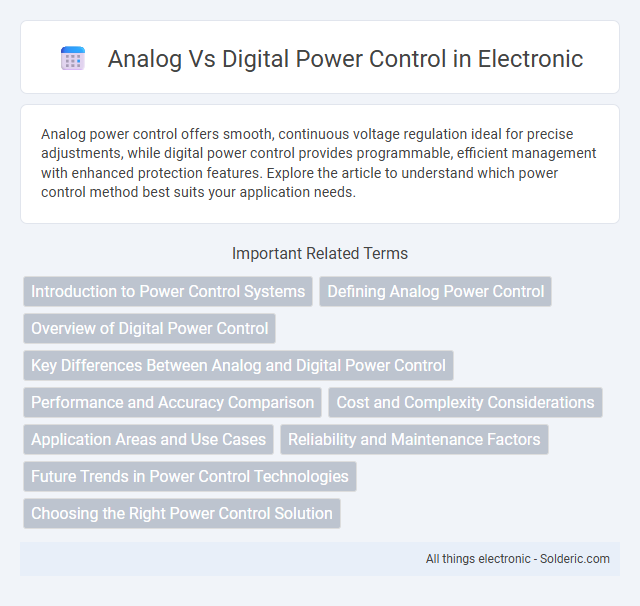Analog power control offers smooth, continuous voltage regulation ideal for precise adjustments, while digital power control provides programmable, efficient management with enhanced protection features. Explore the article to understand which power control method best suits your application needs.
Comparison Table
| Feature | Analog Power Control | Digital Power Control |
|---|---|---|
| Signal Type | Continuous voltage or current signals | Discrete digital signals (binary) |
| Precision | Limited by noise and component variations | High precision with digital resolution |
| Adjustment Speed | Fast, but less flexible | Slower due to processing, but programmable |
| Complexity | Simple circuitry, easier implementation | Complex circuits and firmware required |
| Cost | Lower initial cost | Potentially higher due to components and design |
| Reliability | Susceptible to signal degradation | More robust, less prone to noise |
| Integration | Standalone analog components | Integrates with microcontrollers and DSPs |
| Scalability | Limited by analog component constraints | Highly scalable and customizable |
Introduction to Power Control Systems
Power control systems manage the delivery and regulation of electrical energy to optimize efficiency and performance across devices and applications. Analog power control relies on continuous voltage or current adjustments for smooth modulation, while digital power control utilizes discrete signals and microprocessor-based algorithms for precise and programmable management. Understanding the fundamental differences between analog and digital approaches is essential for selecting the appropriate system in applications such as motor drives, power supplies, and renewable energy sources.
Defining Analog Power Control
Analog power control involves continuously varying the power output by adjusting voltage or current levels, enabling smooth and precise regulation of electrical devices. This method relies on analog signals, such as variable resistors or pulse-width modulation, to maintain optimal performance and energy efficiency. Your choice of analog power control can enhance device responsiveness and reduce electromagnetic interference in sensitive applications.
Overview of Digital Power Control
Digital power control utilizes microprocessors and digital signal processors to monitor and adjust power delivery with high precision and programmability. This approach enables real-time feedback, adaptive algorithms, and seamless integration with smart grids and IoT devices, enhancing energy efficiency and system reliability. Compared to analog methods, digital power control offers superior accuracy, scalability, and diagnostic capabilities in modern power management systems.
Key Differences Between Analog and Digital Power Control
Analog power control continuously adjusts voltage or current using linear components, offering smooth and precise modulation in real time. Digital power control uses discrete signals and microcontrollers for programmable, flexible, and scalable power management with better integration in complex systems. Your choice depends on the required accuracy, response time, and system complexity for optimal energy efficiency.
Performance and Accuracy Comparison
Analog power control offers continuous voltage adjustment with high resolution, providing smooth and precise output suitable for applications requiring fine tuning and minimal noise. Digital power control, leveraging microcontroller algorithms and feedback loops, enables programmable, repeatable, and easily adjustable power levels with enhanced stability and protection features. Your choice should consider analog's superior real-time accuracy versus digital's flexibility and integration capabilities for optimal performance in specific use cases.
Cost and Complexity Considerations
Analog power control systems generally have lower initial costs due to simpler circuit designs and fewer components, making them cost-effective for basic applications. Digital power control offers enhanced precision and flexibility but typically involves higher development expenses and increased complexity from microcontrollers or digital signal processors. Your choice depends on balancing budget constraints with the need for advanced features and scalability in your power management solution.
Application Areas and Use Cases
Analog power control is widely used in applications requiring smooth, continuous adjustment such as audio amplifiers, electric motor speed control, and lighting dimmers, where precise voltage or current regulation is critical. Digital power control excels in complex systems like renewable energy management, smart grids, and microprocessor power regulation due to its programmability, accuracy, and integration with digital communication protocols. Industrial automation and consumer electronics increasingly adopt digital power control for improved efficiency, real-time monitoring, and adaptive performance.
Reliability and Maintenance Factors
Analog power control systems offer high reliability due to their simple circuitry and fewer components prone to failure, resulting in reduced maintenance needs. Digital power control provides enhanced diagnostic capabilities and remote monitoring, allowing for proactive maintenance and faster troubleshooting. Your choice impacts long-term system uptime, with analog favoring robustness and digital emphasizing predictive maintenance efficiency.
Future Trends in Power Control Technologies
Future trends in power control technologies emphasize integrating digital power control systems with advanced algorithms and IoT connectivity to enhance energy efficiency and real-time monitoring. Analog power control remains relevant for low-latency and high-reliability applications but is increasingly supplemented by digital techniques for precise regulation and adaptive response. Innovations such as machine learning-based predictive control and wide-bandgap semiconductor devices are expected to drive the evolution from traditional analog controls toward fully digital, smart power management solutions.
Choosing the Right Power Control Solution
Selecting the appropriate power control solution depends on factors such as precision, response time, and system complexity. Analog power control offers smooth, continuous adjustments ideal for applications requiring fine tuning and low latency, while digital power control provides programmable flexibility, ease of integration, and advanced features like remote monitoring and adaptive algorithms. Evaluating specific application requirements and cost implications ensures an optimal balance between performance and scalability in power management systems.
Analog vs Digital Power Control Infographic

 solderic.com
solderic.com